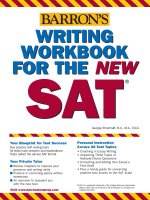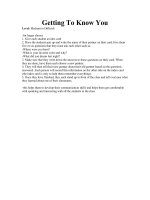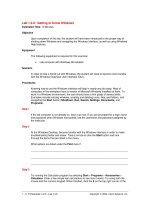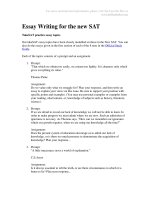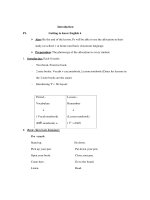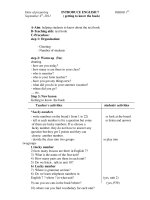Getting to Know the Writing Section of the New SAT
Bạn đang xem bản rút gọn của tài liệu. Xem và tải ngay bản đầy đủ của tài liệu tại đây (97.8 KB, 10 trang )
Old versus New
Minor changes have been made to the Math and Verbal sections. Math topics have been expanded to include expo-
nential growth, absolute value, and functional notation. Familiar topics, such as linear functions, manipulations
with exponents, and properties of tangent lines, are given greater emphasis. Skills such as estimation and num-
ber sense will be tested in new formats. The Verbal section is now known as Critical Reading, and has added short
reading passages while eliminating analogies.
The biggest change to the new SAT is the addition of a Writing section; however, all of the material in this
section isn’t entirely new. The Writing section has three parts; the first two are multiple choice, and the last is essay
writing. You’ll have 35 minutes to complete the multiple-choice section, which is broken down into 25- and 10-
minute parts. It contains the same structure and content as the “old” SAT II Writing Test (which was optional,
CHAPTER
Getting to Know
the Writing
Section of the
New SAT
For over 80 years, high school juniors and seniors have faced the SAT
on their paths to college. During that time, the test has undergone some
changes. However, the new SAT, offered for the first time in March
2005, represents the most significant change in the history of the test.
What does that mean for the more than two million students who take
the test each year? They’ll miss more of the Saturday on which they
take it: The old SAT was three hours long, and the new one is almost
four. Instead of two sections, the test now includes three, and the top
score is 2,400 instead of 1,600. But of even greater importance are the
changes within those sections. Let’s look more closely at what today’s
students will encounter with the new SAT.
1
1
and has now been eliminated), and includes 49 ques-
tions designed to measure your knowledge of basic
grammar and usage rules as well as general writing
and revising strategies. The questions consist of three
types: identifying sentence errors, improving sentences,
and improving paragraphs. Preceding the multiple-
choice section is the essay, for which you are given a
prompt to which you have 25 minutes to respond.
Here’s an overview of each section:
■
Essay. The essay will always be the first section on
the SAT. You’ll get a prompt, which will either be
one quote, two quotes, or a sentence that you
must complete. Then, there is an assignment that
explains what you need to do. You might have to
agree or disagree with a quote, develop your point
of view about an issue related to a quote, or
explain the choice you made in the sentence
completion.
■
Identifying Sentence Errors. In each question is
one sentence with four words or phrases under-
lined. You need to determine which underlined
portion, if any, contains an error.
■
Improving Sentences. Each question contains
five versions of a sentence—you choose the one
that is most clear and correct.
■
Improving Paragraphs. Only about 10% of the
questions in the writing section are this type,
which is good news. They are the most time-
consuming, with five or six questions relating to a
passage of about 200 words. The questions can
involve organization of paragraphs, sentence
order, word choice, and grammar issues.
Coachability
The SAT, including the new Writing section, is often
referred to as a coachable test. That means you can
improve performance through study and practice,
whether with this book, software, or a course. In fact,
many companies in the test-preparation business tout
a hundred- or more point gain for their students. Dili-
gent preparation or coaching is a combination of three
critical components:
1. studying the material that will be presented
2. studying the test itself
3. practicing by taking mock tests
For most students, working through the second
and third components makes the most difference on
test scores. You’ve already learned the math, grammar,
and critical reading skills that are tested on the SAT.
While you might need a refresher on some of those
skills, what’s even more important is understanding the
test itself. In this book, we’ll review misplaced modi-
fiers, but we’ll also reveal how they’re used on the test,
and how you can spot them more easily. When you are
very familiar with the test’s format through study and
practice, your performance will improve.
Strategies for Test Taking
One of the factors cited in the coachability argument is
the fact that there are methods of approaching the SAT
that work much better than others. For example, when
you know that it only makes sense to guess when you
can eliminate one or more multiple-choice answers,
you are much more likely to get a better score. Likewise,
be aware that there are easy questions, which come
first, and harder questions, which appear at the end of
the test. It makes sense to answer the easiest first
because the computer scoring your test does not
discriminate—each right answer, whether to a difficult
or simple question, counts for just one point. Your
objective is to get as many right as possible within the
allotted time. Hard questions may take a couple of
minutes to think through, while during the same time,
you could have answered three easier questions.
–
GETTING TO KNOW THE WRITING SECTION OF THE NEW SAT
–
2
Determining the Level of
Difficulty
How do the writers of the SAT determine the level of
difficulty of each question? Before the question is
included in the actual test, it’s put into an experimen-
tal or “equating” section. If you haven’t heard about this
section before, here’s the scoop: Every test contains
one of these sections, and it doesn’t count toward your
score. However, since there’s no way to know which sec-
tion it is, apply yourself equally to all of the material on
the test; don’t waste time trying to identify the experi-
mental one.
Once an experimental test section has been given,
the Educational Testing Service (ETS) looks at the
results. If most test takers get a question right, it’s deter-
mined to be easy, and if most get it wrong, it’s hard. The
questions in each section, then, are organized from
easiest to hardest. If there are fifteen sentence errors
questions, five will be easy, five will be average, and five
will be hard.
More specific strategies for each section will be
given in Chapters 2 and 3, but here are a few more
general pointers:
Study the directions before taking the test.
Following the directions exactly is critical. Why
spend valuable time during the test poring over
them? The College Board, which administers the
SAT, reveals the directions word-for-word on their
website (www.collegeboard.com). Study and under-
stand them ahead of time, and you’ll have more time
to spend answering questions and scoring points.
Skip questions you don’t know how to answer.
You can leave questions blank and still get a good
score. It doesn’t make sense to spend a lot of time on
a really difficult question if you can skip to others
that could be easier for you. If you have extra time,
you can go back to the tough ones and try again.
Read carefully.
Moving too fast can hurt your score. Multiple-choice
questions, especially the last few, can be subtle. If you
miss a word, or otherwise read the question incor-
rectly, you’ll probably get it wrong. Essays that don’t
directly address the topic get a zero (the lowest score)
no matter how well written they are.
Use your test booklet.
During the test, your booklet may be used to flag
questions you’ve skipped (you may have time to get
back to them), underline or circle key words in a
question, and/or eliminate choices you know are
wrong. Go ahead and mark up your booklet—once
you’re done with it, it’s headed to a paper shredder.
Be aware of the time.
When time is called, you must put down your pencil
and close your book. Keep track so you aren’t caught
off guard; taking practice tests with a timer will help
you familiarize yourself with the number of ques-
tions and their difficulty in relation to the clock.
Remember that if you finish a section early, you can
go back and try those you skipped, or check your
answers (only in that section).
–
GETTING TO KNOW THE WRITING SECTION OF THE NEW SAT
–
3
Snacking on Test Day
The new SAT is 30 minutes longer than its previous incarnation, so the breakfast you ate before taking the
test won’t give you enough energy to get through it. It’s a great idea to bring foods that give you long-lasting
energy rather than sugary snacks that temporarily elevate your blood sugar. Think nuts, dried fruits, and
cheese (not strong-smelling), as well as bottled water, to improve stamina and concentration.
4
Come prepared.
Bring with you:
■
your admission ticket
■
sharp, number two pencils (at least two)
■
a good eraser
■
identification with photo (such as a driver’s
license, a school- or government-issued ID card,
or a valid passport)
■
a watch (if it has an alarm, turn it off)
■
snacks, including water: These must be in sealed
containers within a book bag and can only be
consumed out of the testing room during breaks.
Leave at home:
■
blank paper, notes, books, and dictionaries
■
highlighters, pens, and colored pencils
■
portable listening or recording devices
■
cell phones and pagers
Scoring
The Writing section is scored in two ways: Multiple-
choice questions are scored by a machine, and the essay
is scored by two graders. The machine simply reads the
marks you made with your number two pencil. It gives
you one point for every correct answer, deducts a quar-
ter of a point for every incorrect answer, and gives you
zero points for questions left blank.
Should You Guess?
Every multiple-choice question has five possible
answers, meaning that if you have no idea which is
correct, a guess will give you a 20% chance of getting it
right. But if you guess wrong, you’ll lose one-quarter of
a point. In other words, for every five questions you
answer with random guessing, you’ll probably get one
right. But you’ll lose a point for the four you got wrong.
That means random guessing is a waste of time. If you
can’t eliminate even one answer, skip the question.
But what if you can eliminate one or more answer
choices? If you are positive one answer is wrong, you
now have a 25% chance of getting it right, up from 20%
if you couldn’t eliminate any answers. That means for
every four questions you answer this way, one will be
right. Subtract the three-quarters of a point you lose for
the three wrong answers, and you are ahead a quarter
of a point. If you can positively eliminate two answers,
and are guessing between the remaining three, you’ll be
ahead even more. Therefore, if you can narrow down
the answers by even just one, it makes sense to guess.
Address the Topic
It can’t be stressed enough how important it is to clearly address the topic. You can write an incred-
ible essay filled with unique insights, mature diction, and outstanding organization and development.
But if it doesn’t address the topic, it will receive a zero.
5
The Essay
Scorers of the essay are high school and college teach-
ers who use a scale of 1–6; their two scores are com-
bined to reach an essay score of 2–12. (Note, however,
that an essay written off-topic, no matter how good,
will receive a zero.) If the two scores vary by more than
a point, a third reader scores it.
Essay scorers are trained to use a holistic
approach, meaning they consider the essay as a whole,
rather than word-by-word. Big issues, such as organi-
zation and structure, count more than little ones, such
as an errant spelling mistake or extraneous comma.
That means essays receiving a twelve may have a cou-
ple of mechanics errors.
Specifically, scorers look for three things:
1. development of a point of view in response to
the topic
2. strong supporting examples and details
3. skillful use of language
Don’t get put off by the third requirement. Scor-
ers know you have just 25 minutes to write your essay,
so they don’t expect perfect grammar and punctuation
(although it certainly won’t hurt!). They will look for
word choices that reflect a strong vocabulary (avoid
clichés and slang), variety in sentence structure, and
logical development of ideas. We’ll go into greater detail
about essay specifics in Chapter 3.
SAT Study Timetable
Whether you’re reading this book six weeks or six
months before you take the SAT, the steps in your
timetable remain the same.
Now
Take a practice test, such as the one in Chapter 4. Score
your test and analyze the results. For each incorrect
response, ask yourself:
■
Was there something you needed to know that
you didn’t know? Make a list of the topics you
need to review and devote extra time to studying
them.
■
Did you misunderstand the question? What about
the question confused or tricked you?
■
Did you make a careless mistake? Careless mis-
takes include transference errors (marking the
wrong oval on the answer sheet) and simple mis-
reading, such as mistaking one word for another.
When you’ve finished your analysis, use it to make
a list of your strengths and weakness. You’ll see which
specific skills need reviewing, and which test-taking
skills need improving. Then, get out your calendar.
How much time can you realistically devote each day
and each week to your SAT preparations? Estimate
how long you can spend on each of the four question
types.
